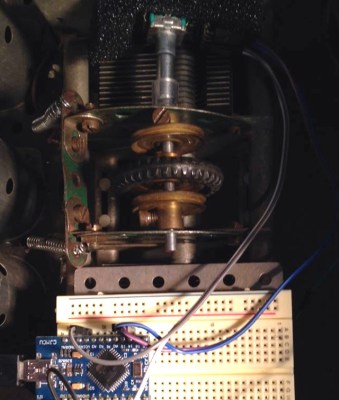The arrival of affordable software defined radio technologies over the last couple of decades has completely changed the way that radio amateurs and other radio enthusiasts approach the airwaves. There’s a minor problem with most software defined receivers though, being by their nature software driven they will usually rely on a host computer for their interface. Thus the experience is one of clicking mouse buttons or using keyboard shortcuts rather than the mechanical analogue dial interfaces that provided easy control of older radios.

This is a problem that has been addressed by [Jon Hudson, G4ABQ], with one of his SDRplay receivers. He’s mounted it and its control PC in the chassis of a very aged and non-functional Marconi CR100 communication receiver, and given it a control interface that only uses the Marconi’s front panel controls (YouTube link). A rotary encoder has been grafted onto the Marconi tuning capacitor with what looks like some Meccano, and in turn that feeds an Arduino which behaves as a keyboard for the benefit of the PC. Some extra buttons have been added for mode selection, spectrum zoom and shift, and care appears to have been taken to give their labels a period feel. Arduino code came courtesy of [Mike Ladd, KD2KOG]. The result is a very controllable SDR receiver, albeit one in a rather large case.
If you are interested in the project then we are told that it will be on the RS stand at Electronica in Munich next week, meanwhile we’ve put the video below the break.
On one hand it seems almost sacrilegious to defile a classic communications receiver in this way, but on the other there is no shortage of similarly broken kit of the era that is little more than junk. At least this one has been saved from the fate of gathering dust under some OM’s bench.
If SDRs are new to you, here’s our introduction to them. We’ve featured SDRplay before in our look at GNU Radio, and over the years we’ve featured more than one homebrew SDR.

















Nice one!
Is the sdrplay any good?
Haven’t heard from it until now.
Hardware’s fine but the drivers are all binary blobs.
But… why?
No. Just no. This is an ABOMINATION; a herpetic hetrodyne homonculus. Kill it with fire!
People will go to extremes to restore an old radio, making parts even, and taking one in worse shape to supply parts.
It’s long after the fact for tube radios. There was already a long period when they were tossed, and then nobody wanted them. So lots of modifications, legit back then, but now grumbled about. Or cabinets turned into liquor cabinets, the electronics discarded.
What’s left is a much smaller sample. They have monetary value because fewer remain, but also because the old is now more appreciated. That latter will make the collector howl over this sort of thing.
The problem is, different people will, interpret value differently. That old clunky cellphone will go to ewaste recycling, since the average person knows it is obsolete, while the hobbyist would see it as useful source of parts, especially RF. Someone tosses their stereo because they no longer want something big, even though it still works fine and is better than an iPod dock.
And someone junks an “antique” radio because they think it’s obsolete, so gut it to make something else. But someone else might value it more, and have the capacity to restore it.
The concept here is good, but so little of the radio is used, one could have easily made up a front panel and scrounge some old dial, and make that old look for controlling software. This isn’t a mod, it’s tossing the radio for the sake of using the front panel.
Michael
Piles and piles of iPod docks at thrift stores now due to change to lightning connector.
life sucks. get over it. if this supposed someone wanted that radio badly enough, they would have bought it.
Nice project! You have space in there for a tuneable band pass filter. I currently have a Funcube Pro+ and it is useless on HF without a BPF to give it some front end selectivity. Is the SDR play less prone to receiving stray signals?
Novel use for those old Meccano wheels by the way!
+1 for noticing they were Meccano wheels. Sheesh, good eye!